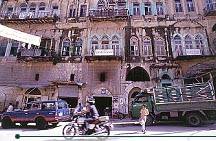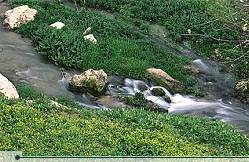 |
Keys
to the Kingdom National Anthem The Office Touristic Sites |
The town of Salt was of great importance in the 19th and early 20th century, during the time of Turkish rule in Jordan. It was the chief administrative center for the surrounding area and, in the 1920s, it seemed the likely choice for the capital of the newly-independent state of Transjordan. However, Salt was bypassed in favor of the more centrally located village of Amman. The result is that Amman has been transformed into a thriving modern city, while Salt has retained its small town charm. |
 The architecture of Salt. © Zohrab |
| Due to
its history as an Ottoman center of government, Salt is filled with wonderful Ottoman
architecture in the classical style. Immediately recognizable are the Ottoman houses with
their long-arched windows. An array of tall Ottoman minarets towers over the village,
along with church steeples, as Salt is also known for its Christian community. A morning
or evening spent strolling through the picturesque streets of this charming hill village
is time well spent. Salt is also the final resting place of the Prophet Ayyoub (Job), whose legendary patience and faith gave him strength to endure tremendous hardships and ultimately be rewarded with blessings (Job 1-3, Quran 38: 41-44). Another prophet—Shu'ayb (Jethro), the Midianite father-in-law of Prophet Musa (Moses)—is said to be buried in a tomb near Salt in Wadi Shu'ayb. Salt is about thirty kilometers northwest of Amman. Just before you enter the main part of the city (from Amman), you will see the Department of Antiquities Museum and the Tourist Office on the left. The museum houses an assortment of pottery and coins dating from the Chalcolithic period (4500 BCE) through the Mamluk period (1516 CE), as well as Byzantine mosaic panels and early photographs of Salt. The museum is open 08:00-14:00 every day except Friday. Entrance is free. Just off the main street is the Salt Cultural Center. This complex, which opened in 1989, houses another museum, a library, a handicraft school and Salt’s main hall. The handicraft school teaches ceramics, weaving, silk screen printing and dyeing to students, who then sell their craftwork, making the project self-financing. The project is sponsored by the Noor al-Hussein Foundation and the Salt Development Foundation. |
|
Around 24 kilometers southwest of Amman, the high desert plateau suddenly gives way to the lush, tree-covered valley of Wadi Seer. About 10 kilometers past the village of Wadi Seer, which was settled largely by fair-skinned, red-headed Circassians, the road leads to the ruins of Qasr al-Abd (Castle of the Slave) and the ancient caves of ‘Iraq al-Amir (Caves of the Prince). |
 Wadi Seer. © Zohrab |
| Local
legend has it that Qasr al-Abd was built by a love-smitten slave named Tobiah. While his
master was away on a journey, Tobiah built a palace and carved lions, panthers and eagles
on its walls in order to win the love of his master’s daughter. Unfortunately, the
master returned before Tobiah could finish the work, and the slave’s efforts went
unrequited. Little is known for sure about the actual history of this castle, but it is widely believed to have been built in the second century BCE by Hyrcanus, head of the powerful Tobiad family and governor of Ammon. The name "Castle of the Slave" may thus refer to Hyrcanus himself, who, as governor, was a "slave of the people." The first-century historian Josephus recorded the wealth of the Tobiad family and the exploits of Hyrcanus, who built a strong fortress of white stone which was decorated with carvings of "animals of a prodigious magnitude." Perhaps the most interesting part is the north entrance, with one of the original carved animals, a giant stone lion, peering down over all who pass underneath. The entire building was once covered with such figures. The estate was originally surrounded by a wall and included a lake and a park with trees and shrubs. The castle itself is unique, in that it was built from some of the largest blocks of any building in the Middle East. The largest block measures seven by three meters, but as most were only about 40 centimeters wide, the whole construction was quite flimsy. An earthquake in 362 CE completely flattened the palace. The ruins of Qasr al-Abd have been partially restored, thanks to the efforts of a French archeologist who spent three years making detailed drawings of the fallen stones. After having made cardboard cutouts of each stone and piecing the "jigsaw puzzle" together, he then spent another seven years on the actual reconstruction. The result is a fine monument which has, so far, remained mostly undiscovered by tourists. As you return up the valley, stop around 500 meters from the Qasr. On the left you will find a group of caves cut from the rock. These are known as ‘Iraq al-Amir. The caves, eleven in total, are arranged in two tiers and are thought to be man-made. They were once used as cavalry stables, while the villagers today use them to house their goats and store chaff. At the front of one of the caves, easily recognizable by its carved doorway, the word "Tobiad" is engraved in Aramaic. This gives credence to the theory that Qasr al-Abd was built by the Tobiad family. |